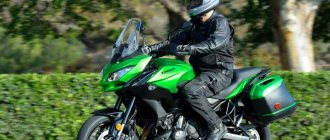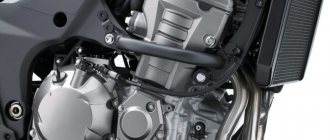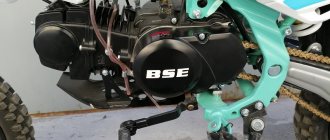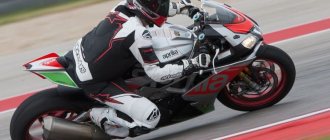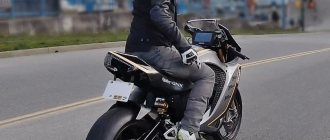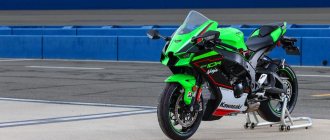| Kawasaki Versys-X 300 (2017+) |
Touring enduro model Kawasaki Versys-X 300
was first introduced in 2016 as a junior budget model in the Versys line, aimed at beginner motorcyclists. The model is based on the engine from the sports version of the Kawasaki Ninja 300, which, practically unchanged (only the intake system, filter box has changed, lighter pistons have been installed) was migrated to the Versys-X 300 - this is a 2-cylinder in-line liquid-cooled unit producing about 40 liters .With. power and almost 26 Nm of torque. The motor is high-speed, with maximum performance at 10,000-11,000 rpm. The gearbox is a 6-speed with a slipper clutch.
The frame of the Kawasaki Versys-X 300 is a steel structure, the load-bearing element of which is the engine. The motorcycle's suspension is budget-friendly - a conventional telescopic fork at the front and a monoshock absorber with adjustable preload at the rear, travel - 130 and 148 mm, respectively.
The braking system is completely disc - one disc for the front and rear wheels. ABS system available.
The following accessories are available for touring options on the Kawasaki Versys 300: saddlebags, tubular steel engine protection, LED fog lights and hand protection.
A 250 cc version of the motorcycle is available for the domestic Japanese market - Kawasaki Versys-X 250.
The main competitors of the Kawasaki Versys-X 300 in the class:
- Honda CRF250L Rally
- Suzuki DL250 V-Strom
Brief history of the model
- 2016 - the Kawasaki Versys-X 300 model was first presented at the EICMA 2016 exhibition in Milan.
- 2017 - official start of sales of Kawasaki Versys-X 300.
Model
: Kawasaki Versys-X 300 / Kawasaki Versys-X 300 ABS (North America, Europe, Australia).
Factory designation
: KLE300BHF / KLE300CHF.
- 2018 - no significant changes.
Model
: Kawasaki Versys-X 300 / Kawasaki Versys-X 300 ABS (North America, Europe, Australia).
Factory designation
: KLE300BJF / KLE300CJF.
- 2019 - no significant changes.
Model
: Kawasaki Versys-X 300 / Kawasaki Versys-X 300 ABS (North America, Europe, Australia).
Factory designation
: KLE300BKF / KLE300CKF.
- 2020 - no significant changes.
Model
: Kawasaki Versys-X 300 / Kawasaki Versys-X 300 ABS (North America, Europe, Australia).
Factory designation
: KLE300BLF / KLE300CLF.
- 2021 - the model leaves the European market. Non-ABS versions are no longer offered in the North American market.
Model
: Kawasaki Versys-X 300 ABS (North America, Australia).
Factory designation
: KLE300CMFAN (Australia), KLE300CMFAL (North America).
- 2022 - no significant changes.
Model
: Kawasaki Versys-X 300 ABS (North America, Australia).
Factory designation
: KLE300CNFAN (Australia), KLE300CNFAL (North America).
A look from the outside and from the inside
The Japanese decided to do everything to reduce the cost of the motorcycle, so the Versys 650 received a conventional steel diagonal frame, suspension with moderate travel, a 6-speed gearbox and a 2-cylinder liquid-cooled engine. The power unit and transmission were borrowed from the aforementioned “ruff”, and also retuned for more torque at low and medium speeds. Externally, the first generation of the bike turned out to be quite controversial, but recognizable and unlike its competitors. In the second generation, the appearance of the Kawasaki KLE 650 Versys changed slightly, retaining the originality of its appearance, but in 2015, the third generation entered the series, outwardly suspiciously reminiscent of the Yamaha FZ-6. However, appearance is a purely subjective question, and besides, tourist enduros are not chosen for their beauty. In 2016 and 2022, no significant changes were made to the Versys 650, nor in 2022, so if we wait for updates, it will not be until 2022.
Having learned the technical characteristics of the Versus 650, you understand that this bike is not enough stars from the sky. No, it is quite capable of showing its tail to 95% of the cars on the road, but this does not explain its popularity. Another thing explains it - for a moderate amount the buyer gets a truly universal motorcycle, capable of a lot. In addition, a touring enduro is a priori designed for travel, and on long trips, reliability is the most important parameter. In the case of the Kawasaki Versys 650, a significant advantage is that it is designed using components that have already been time-tested on other Kawasaki bikes. Yes, this makes the Versys 650 not the most modern, but you can rest assured when traveling on a motorcycle for a couple of thousand kilometers - with proper maintenance it will not let you down.
The 65-horsepower Versys 650 engine (69-horsepower since 2015) performs well at mid-range speeds, peaking at 8,000 rpm. Peak torque (61 Nm, or 64 Nm since 2015) occurs in the range of 6800-7000 rpm, which allows you to continue vigorous acceleration after engaging top gear without losing dynamics. Even with a passenger and cargo, the dynamics of the Kawasaki Versus 650 are quite sufficient for both the city and the track - after all, you are on a public road, not on a race track, right?
The brakes can be called quite good, and with ABS - even good. It could be better, of course, but then the Versys 650 would cost noticeably more, and the brakes are quite a strong 4 on a 5-point scale. Let us only note that good tires and brake pads are no less important for braking efficiency than brake discs and calipers, and it is clearly not worth saving by buying tires and pads that have become hardened by age at a discount on Aliexpress. Brakes are life.
Specifications
Technical characteristics of Kawasaki Versys-X:
| Model | Kawasaki Versys-X 300 |
| Motorcycle type | touring enduro |
| Year of issue | 2017+ |
| Frame | steel tubular |
| engine's type | 2-cylinder, 4-stroke, in-line |
| Working volume | 296 cm³ |
| Bore/Stroke | 62.0 x 49.0 mm |
| Compression ratio | 10.6:1 |
| Cooling | liquid |
| Number of valves per cylinder | DOHC, 4 valves per cylinder |
| Fuel supply system | injector, 2x 32 mm |
| Ignition type | transistor |
| Maximum power | 40.0 hp (29.3 kW) at 11500 rpm |
| Maximum torque | 25.7 Nm (2.6 kgf*m) at 10,000 rpm |
| Clutch | Multi-disc in oil bath, cable drive |
| Transmission | 6-speed |
| type of drive | chain |
| Front tire size | 100/90-19M/C (57S) |
| Rear tire size | 130/80-17M/C (65S) |
| Front brakes | 1 disc, 290 mm, 2-piston caliper (ABS) |
| Rear brakes | 1 disc, 220 mm, 2-piston caliper (ABS) |
| Front suspension | 41 mm telescopic fork, travel - 130 mm |
| Rear suspension | pendulum Unitrak with monoshock absorber (adjustable preload), stroke - 148 mm |
| Motorcycle length | 2170 mm |
| Motorcycle width | 860 mm |
| Motorcycle height | 1390 mm |
| Wheelbase | 1450 mm |
| Seat height | 845 mm |
| Minimum ground clearance (clearance) | 180 mm |
| Acceleration 0-100 km/h (0-60 mph) | 6.4 sec[1] |
| Maximum speed | 167 km/h[2] |
| Gas tank capacity | 17.0 l |
| Motorcycle weight (curb) | 175 kg (version with ABS) |
Little Humpbacked Horse: Kawasaki Versys-X 300 2022
The idea of building a motorcycle that would look like a touring enduro, based on the platform of its road counterpart, is not new. Moreover, Kawasaki engineers were among the first to develop it, creating the Versys 650 on the chassis of the road ER-6. The idea turned out to be successful - for most fans of off-road touring vehicles, aesthetics alone were enough.
The seating position, design, increased suspension travel, a couple of off-road attributes such as “burdocks” on the steering wheel and engine protection, hiding behind a simple, reliable and comfortable motorcycle for daily city use, here it is – the image of a modern crossover, a class whose popularity is only growing. It would be strange not to develop this idea further and not go beyond just mid-sized motorcycles.
Meet the Kawasaki Versys-X 300!
This is exactly how the Versys 1000 first appeared, and then our today’s test subject, the Kawasaki Versys-X 300. As usual, it is based on the road Kawasaki Ninja 300, however, unlike its older brothers, the crossover has quite a lot of differences from its asphalt brother . And even though the engine and brakes migrated almost unchanged, other suspensions and chassis allow us to talk more about a new motorcycle than about a deep modification of the old one.
Video version of the Kawsaki Versys-X 300 test drive:
The first thing that catches your eye when you get to know the Versys-X 300 is its size. The device barely shows 300, and looks like 400-600 cubes, hello to the classic Honda Transalp! The design is traditionally conservative; current manufacturers of the Land of the Rising Sun do not pay too much attention to it: traditionally strange shaping, a jumble of chopped shapes and planes, conservative optics using incandescent lamps, with the exception of optional diode fog lights.
With this Versys-X 300 configuration there is no need to complain about the lack of headlight light
But, again, traditionally for today's Japanese, the appearance of the device is saved by pleasant little things - the texture of unpainted plastic, combinations of different colors, matte, semi-matte and glossy elements, materials, and most importantly - the signature acid-green metallic, the best color you can think of for "Cava". In other words, the motorcycle is large and interesting, although the design is far from both competitors from Europe and the older models of the brand.
The designers successfully implemented a combination of chopped surfaces, acid metallic and matte black
The same applies to the feeling in the saddle: it’s spacious here even if your height is close to two meters, the saddle is moderately raised from the ground and narrowed at the base, especially for short riders, the wide handlebar is high enough so that you don’t need to reach for it from standing position, legs not too bent at the knees. In other words, when creating a motorcycle aimed primarily at Asian markets and assembled in Thailand, the engineers also looked at the healthy, tall European, trying to please everyone.
Even riders with impressive dimensions will be comfortable behind the wheel of the Versys-X 300
But the saddle pad is incredibly hard: only the width, which increases with distance from the place where it connects with the tank, allows one to avoid analogies with a bicycle without a saddle. The tank itself is made of steel, and, if you close your eyes to the plastic plug, which makes you want to call it a canister, an impressive 17 liters of volume with a stated consumption of 4 liters per hundred should provide a very good power reserve.
The seat seemed quite hard, perhaps this unit will have to be modified for tourism
In addition, the tank is quite wide and, together with the developed fairing, perfectly covers the rider’s knees from bad weather and wind, and together with the sufficient height of the non-adjustable windshield, the pilot’s isolation from the outside world generally claims to be the best in the segment of small-capacity crossovers.
The Kawasaki Versys-X 300 gas tank capacity is 17 liters
The same applies to the controls - simple remote controls with bright scarlet keys are pleasingly well-made, the space around the dashboard is decorated with textured black plastic with a fog light switch and a full-fledged cigarette lighter socket, and the tidy itself is cooler than on the older Z650! Here you have an analog tachometer with a scarlet needle, a full set of indicator lamps, and a pair of monochrome monitors displaying fuel reserve, temperature, selected gear, speed and many other minor parameters. Of course, it’s not a color LCD panel, but it’s decent for a budget rice grinder.
The dashboard happily greets us with an analogue tachometer needle. I like!
The only things that cause bewilderment are the mirrors with strangely shaped housings that are unified with other models of the green brand and the steering weights, the cone of which is so truncated that only a couple of turns in a lathe separate them from the title of turned peaks. But here, again, it’s a matter of taste and color—some people, on the contrary, will remember and like the original shape. In other words, the Versys-X 300 is just as pleasant from the saddle as it is from the outside, albeit with allowances for its peculiar shaping.
The controls are familiar, it’s comfortable to sit, it’s pleasant to steer – what else is needed for complete happiness!?
The motorcycle is not cheap at all - 456,000 rubles in the basic version is expensive, even taking into account the three original cases that dealers give away upon purchase as part of a promotion valid until the end of July this year.
We got a device literally covered with factory options: original arches, mugs on the steering wheel, a central stand and foglights raise the cost of the motorcycle to almost half a million. Expensive, the difference with the BMW G310GS is dramatic, even if you don’t take into account that the Bavarians position themselves as a premium brand in our market.
Branded arcs look monumental, but they are attached; for some reason, one of the attachment points is a spider
Why such grandmothers?! For the engine: the 300 cc “two” in this class is currently offered only by Kawasaki. And the fact that it is not new, the roots, let me remind you, go all the way back to the Ninja 250 unit, is rather a plus - there are no problems with spare parts or maintenance, the servicemen know this engine and do not particularly criticize it. Volume 296 cubic meters, 40 forces and 25.7 Nm of torque, occurring closer to the red zone, liquid cooling, four valves per cylinder and injector - everything is like in humans.
The two-cylinder in-line engine is already well known to us from the best-selling Ninja 300
But it works nicely - vibrations, although present, are not as annoying as on “single-barrel” guns, and the dynamics are louder. Where the single-cylinder engine finishes pulling, the “two” is just beginning: from six thousand to the red zone of 12-13 thousand, a sufficient range to cheerfully go, watching the figure of 140 km/h on the speedometer, which continues to increase, there would be a place .
Dimensions practically do not give the Versys-X “three hundred”
And although the chassis does not shine with torsional rigidity, the not-too-heavy motorcycle remains comfortable and relatively stable even at the limit. The suspension is simple, there are no adjustments for the classic “telescope” at the front, and the preload for the monoshock absorber, which works through “progression” at the rear, however, the standard settings please with a pleasant density, the speed bumps the motorcycle flies amazingly, the saddle is comfortable even taking into account its rigidity, and The device is good in a rack.
Despite the quite road suspension travel, the motorcycle cheerfully overcomes bumps and speed bumps
Yes, in corners, especially fast ones, the motorcycle begins to sway, but decent travel of 130 mm in the front and 148 mm in the rear, although not the maximum in the class, is obligatory. It is not easy to achieve the best result within budgetary decisions. The same applies to the brakes - there is one disc in front, a floating two-piston caliper, a regular, non-reinforced line. The same goes for the rear, but with even simpler components: no feedback, linearity is lame, but there is enough efficiency, the main thing is to press harder on the levers, without fear of blocking, which is caught by the standard ABS.
There is no provision for disabling ABS, but it is always possible to bypass the prohibition by removing the corresponding fuse
It, by the way, cannot be switched off - for an SUV this is rather a drawback, as is the clutch lever, which is so soft that you can squeeze it with just your little finger. For some reason I always want to feel the clutch, sometimes it needs to slip, and with such a delicate lever it’s not easy to do. But the six-speed gearbox works well, although neutral is not ideal and requires some skill. It's the little things in life.
The optional side cases are unlocked with the ignition key, convenient!
But the wheels are 19 and 17 inches in size, although chambered, but spoked - an important off-road attribute, clearly created with an eye to real, and not hypothetical, off-road. One problem is that the rear cylinder measures 130/80-17 and looks very thin for such a large device. But it’s easier to tilt the device into a turn and shift it from one side to the other.
The standard exhaust does not amaze you with its sound or dimensions
So who is it, the Versys-X 300, a small but touring enduro or a crossover? On the one hand, the dimensions, the size of the spoked wheels, the seating position and a bunch of small “attributes of a nomad” such as the protection of the pan clearly require that it be included in the tourenduro class, on the other hand, there is not so much suspension travel, a riding motor will not be a good companion in a rolled rut or on sand, like non-switchable ABS.
The narrow tank makes the Versys-X easy to ride in a rack
It's up to you to decide, but for me it's more of a small tourenduro with reservations than a crossover; the motorcycle has very solid potential. As for what is expensive, we have not yet seen prices for the KTM 390 Adventure, the debut of which is possible this fall.
Photos of Kawasaki Versys-X 300 2022:
We thank Fuji Motors for providing us with a motorcycle for testing.
Accreditation and organization of test drives – Denis Sokolov | | +7 (999) 851-49-71
Design and ergonomics
Kawasaki designers did not make a revolution and created a very laconic and slightly boring appearance. The Versys-X 300 borrowed many design solutions from the concern’s older models, but its main feature was practicality and functionality, not appearance. The motorcycle has very well developed wind protection, which protects the rider from both wind and bad weather.
In addition, the Versys-X gas tank has a special shape, thanks to which tall riders can sit comfortably on the motorcycle. The engineers also took care of the functionality of the tank; its volume was 17.5 liters, which significantly increased its range.
The execution of the controls is also at the highest level; both remote controls have a pleasant-to-touch plastic with large, bright control buttons.
And the dashboard in some aspects easily outperforms even its older brothers; it easily accommodates a large tachometer with a red needle, a monochrome display with all the information about the motorcycle, as well as a full set of indicator lamps. The narrowest part of the seat is adjacent to the gas tank, but as you move away from it it only gets wider. Although its cushion is firm, it has enough elasticity to ensure a comfortable ride.


